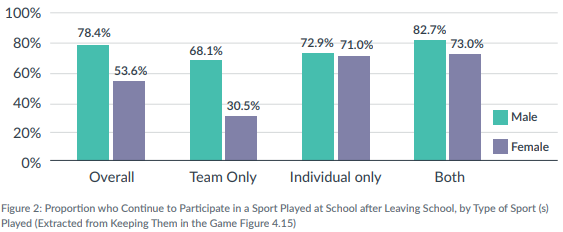Grassroots issues. Teenage girls are three times more likely to quit playing sport as boys.
This week on OTB Sports, we have been looking closely at what the future of Irish grassroots sports might look like.
While 2020 saw a rise in sporting activity across Ireland, a key issue in Ireland’s sport participation numbers is the dropout rate of young women.
A sharp increase in the number of people walking, cycling and running, the rise of wearable tech and the role of exercise in managing the mental health of the nation. These are just some of the headline findings from our annual Teneo Sport & Sponsorship Index #TSSI2020 pic.twitter.com/RscHs6djWP
— Teneo Ireland (@TeneoIreland) December 23, 2020
Much of the work from the likes of Sport Ireland and the 20x20 campaign has been focused on increasing sports participation among women in Ireland, and with good reason. The most recent Irish Sports Monitor (2019) showed a 3.4% difference in women’s participation in sport compared to men’s.
That gap is a huge improvement on the difference reported in 2007 which was nearly four times as large. There is still a difference after big efforts from sporting organisations in Ireland to level the playing field. The statistics highlight where the inequality lies: teenagers.
A 2017 study by Lidl and the LGFA found that by the age of 13, half of the girls in sport in Ireland have dropped out. They are three times more likely to discontinue sport at this age than boys. The 2019 ISM showed a 14% regular playing gap between 16-19-year-old boys and girls.
According to Ireland’s National Sports Policy, “Ninety per cent of children in the later years of Primary School education are regular participants in organised sport”.
Here are some ways Ireland can stop losing teenage girls in sport at such an overwhelming rate...
Why they’re going alone
According to the 2019 ISM, the biggest disparity between men and women in sports participation in Ireland is in team sports.
Soccer, for instance, being about six times as popular among men as it is among women highlights where women are stopping before they really get started.
There is no difference between men’s and women’s participation in Ireland’s most popular individual sport (personal exercise).

Source: National Sports Policy 2018-2027
Psychological research in the area of continuation among sport can help refocus our approach to keeping teenage girls involved with their sport.
Studies have shown the importance of the climate created by coaches for teenagers involved in team sports. Caring climates are associated with a greater commitment to and a higher enjoyment of team sports by teenagers.
Research shows that ‘task-oriented climates’ are key to keeping teenagers enjoying their sport. They can be created by parents, coaches, and teammates. These climates focus on players becoming better than they were previously, rather than those around them.
The parent who watches a Jose Mourinho masterclass on Saturday night and attempts their own version of that during an U-14 Sunday league game the next morning is a problem for teenagers. It hinders the motivation of many to continue.
Coaches, parents and teammates should create an inviting atmosphere that creates a self-perceived competence and enjoyment in playing for teenagers regardless of how an individual is competing with others. Seemingly in Ireland, this is not happening enough at a grassroots level.
This is most likely down to a combination of factors, but educational campaigns on creating the right atmosphere for young athletes to enjoy team sports can help decrease the dropout rate. The players and the parents facilitating them influence the atmosphere, so each should know how best to create this atmosphere.
Grow grassroots by promoting local
Role models clearly influence teenage athletes. Many teenage girls have sporting figures they look to emulate, but what type of profile do these figures tend to be?
There is a lack of strong evidence linking elite athlete role models to the continuation of sport at this age. Studies suggest that coaches, parents and peers are much more influential on a child’s motivation to continue with a sport, so campaigns focusing on these role models can help keep them involved.
The role models on the side of the pitch affect the lives of young athletes more than the ones on our TV screens.
Campaigns focusing on local role models and the positive influence sport brings to their lives can keep young players in the game. That is the building block needed to create more commitment at every level of a sport.
Knowing how good they are
A WomenInSport report found 29% of girls aged 14-16 said not being good at sport stops them from taking part in school sport. Societal problems like body image issues for teenage girls and perceptions of girls belonging in sport are listed as barriers in the report.
The education of coaches involved with clubs and schools across Ireland about improving self-perceived competence can change this, though. This education can go hand-in-hand with learning about task-oriented approaches and the influence of local role models.
These are issues that are being tackled more often in recent years. Initiatives like the 20x20 campaign pushed increased awareness and coverage of women’s sport. It changed many attitudes within grassroots sports in Ireland.
Results of efforts like these have seen participation in women’s sport improve dramatically in recent years. There is much in which to be optimistic.
With more focus on helping teenage girls stick with team sports, more positive change is coming.
Download the brand new GoLoud App in the Play Store & App Store right now! We've got you covered!
Subscribe to OffTheBall's YouTube channel for more videos, like us on Facebook or follow us on Twitter for the latest sporting news and content.








